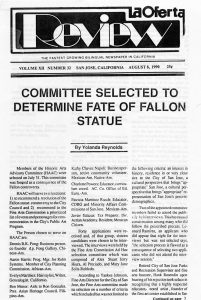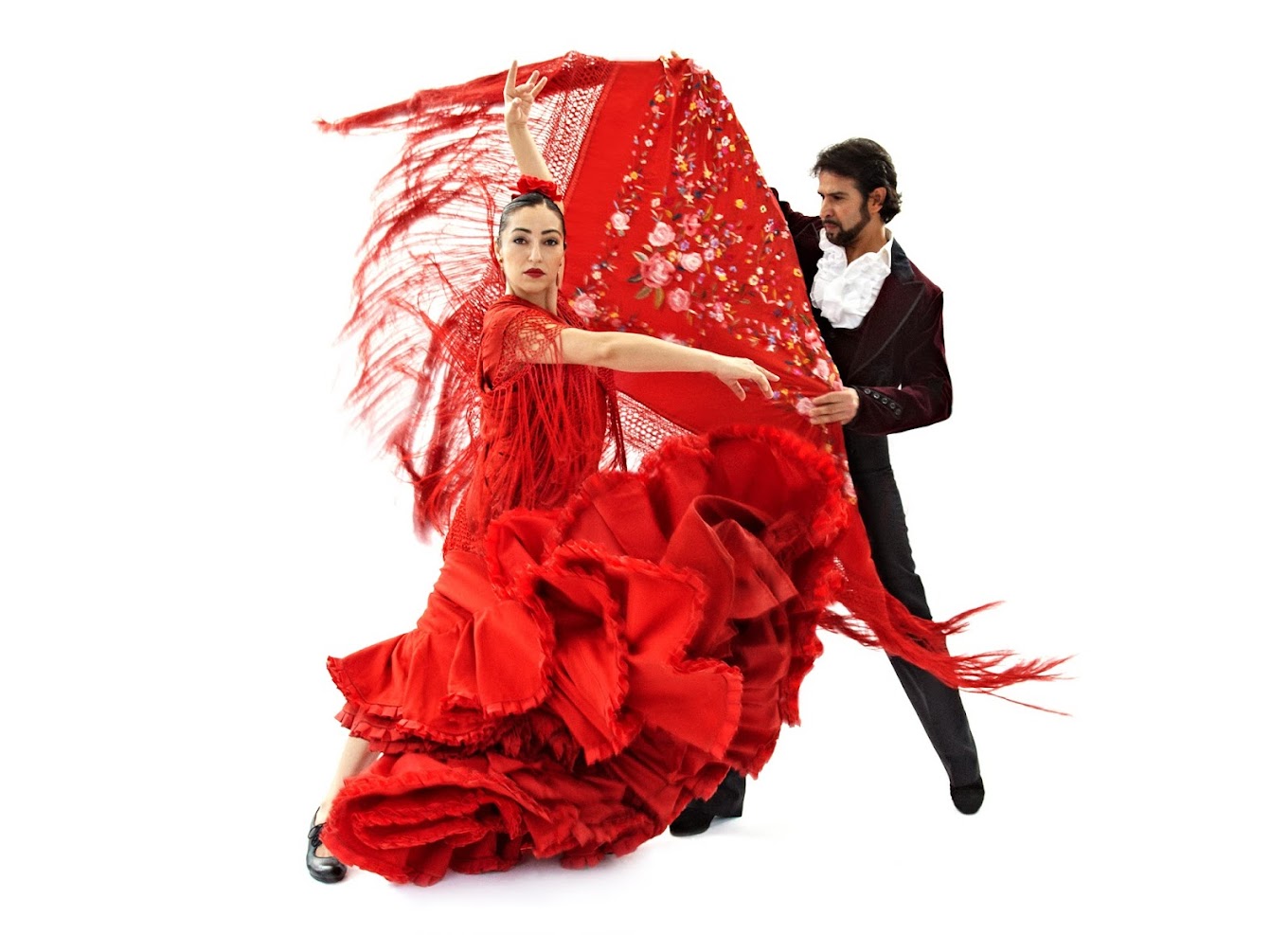August 8, 1990
By Yolanda Reynolds

Members of the Historic Arts Advisory Committee (HAAC) were selected on July 31. This committee was formed as a consequence of the Fallon controversy.
HAAC will serve two functions: 1) to recommend a resolution of the Fallon statue controversy to the City Council and 2) recommend to the Fine Arts Commission a prioritized list of events and personages for commemoration in the City’s Public Art Program.
The Persons chosen to serve on HAAC are:
Dennis B.K. Fong: Business person, co founder d.p. Fong Gallery. Chinese-Am.
Aaron Harris: Prog. Mgr. for Rolm Systems. Member of City Planning Commission. African-Am.
Evelyn Martinez: Hairstylist, Writer, Genealogist. Californio.
Ben Menor: Aide to Ron Gonzales. Pres. Asian Heritage Council. Filipino-Am.
Kathy Chavez Napoli: Businessperson, active community volunteer. Mexican-Am. Native-Am.
Charlotte Powers: Educator, curriculum coord. AC. Co. Office of Ed. Euro.-Am.
Patricia Martinez Roach: Educator, CDBG and Minority Affairs Commissions of San Jose. Mexican-Am.
Javier salazar: Tax Preparer. Dir. Aztlan Academy. Resident. Mexican Citizen.
Forty applications were received and, of that group, sixteen candidates were chosen to be interviewed. The interviews were held by the Fine Arts Commission Ad Hoc selection committee which was composed of Alex Stuart, Jerry Hiura, Al Preciado, and Mary Jane Solis-Robledo.
According to Yankee Johnson, Fine Arts Director for the City of San Jose, the Fine Arts committee made its selection on a number of criteria which included but was not limited to the following criteria: an interest in history, residence in or very close ties to the City of San Jose, a cultural perspective that brings “appropriate” San Jose, a cultural perspective that brings “appropriate” representation of San Jose’s present-demographics.
Two of the appointed committee members failed to attend the publicly held interviews. This has caused consternation among many who did follow the prescribed process. Leonard Ramirez, an applicant who did appear that night for the inter views but was not selected says, “the selection process is flawed as a consequence of selecting two applicants who did not attend the interview session.”
Retired City of San Jose Parks and Recreation Supervisor and fine arts booster, Hank Rosendin upon hearing of his rejection took solace in recognizing that a highly respected educator, noted artist, founder of the first art center established in San Jose. John de Vicenzi was also rejected. Hank Rosendin said. “I am honored to be in the company of such a fine person as Mr. De Vicenzi.”
In addition to the above, individuals were appointed from existing City Committees to serve on HAAC. Exactly how these representatives were chosen has not been made apparent.
Committee For The Past: Leonard McKay and Chuck Buckley. Historic Landmarks Commission: Colleen Cortese.
Fine Arts Commission: Alex Stuart and Jerry Huira.
Art Selection Panel: Pierre Prodis and Patty McDonald. (Ethnicity and occupation not revealed).
The first HAAC meeting was held Monday. According to Director Johnson. the first order of business will be to decide what to do about the Fallon statue. He says that unless other options surface. There are four that will be considered: 1) No Fallon statue in San Jose; 2) Place Fallon statue as originally proposed. On the north island of Plaza Park: 3) Locate Fallon somewhere else in San Jose or; 4) Store Fallon until the prioritized list of events and personages are decided upon for commemoration in the city and decide then whether to erect the statue or not.
Mayor McEnery, in March of 1990, sent to Pierre Prodis, then Chairman of the Fine Arts Commission, a list of 19 people that the Mayor thought should be given consideration for commemoration “via public statue, murals, busts or paintings.” Included in this list along with St. Joseph, are such individuals as Anthony P. Dutch Hammon, Vic Corsiglia Sr., Mary Hays Chynoweth, John C. Fremont and Antonio Mario Pico.
Some people have suggested that expenditures of public money commemorating the past in the manner as suggested does not properly reflected the community in a comprehensive manner. They suggest that a broader view is necessary in order to achieve this. Suggestions have been offered to commemorate the “immigrant experience” or the “agricultural experience” among others. Such themes would result in a more inclusive, accurate image of the past and also require greater artistry and creativity.
It is expected that the work of the committee will require much thought, effort and time particularly for the development of prioritized list for commemorative art.
Arts Director Johnson says that all of the meetings are to be open to the public and that public participation and testimony is welcomed and expected. The community expects that the requirements of the Brown act will pertain to this committee and that the time and agenda announcements of all meetings, as well as decisions, will be made in an open and timely manner.
There will be much debate about the proposed statue commemorating Mr. Fallon and the”raising of the American flag. As more has been learned about Mr. Fallon, the opposition to his glorification has increased’.
Retired Major Theodore Baltes, a recognized military historian, says that if stories and accounts of “Fallon’s flag raising” are accurate, Fallon did not formally “raised the flag.“ Baltes says that ‘flag raising” has a prescribed protocol that has been honored by the military since the 1970’s. Baltes says a soldier does not “raise the flag” by riding a horse through town while holding a flag as if in fear of being pelted or shot. A “flag raising” requires a flag pole and ceremony.
Many have been disturbed by the account of how Fallon treated his mother-in-law Dona Martina Lodge Depeux. In an article recently published in The Mid-County Post, based in Capitola, Ca. Fallon is described by historians as being the ring leader who organized the Castro in-laws to demand that she partition the Castro property among them, eventually taking her to court over the dispute. She eventually lost the property. though it is not clear to this writer as to how the property came into the ownership of the local church. It was these priests that Fallon later defrauded in a property dispute regarding the same Castro lands.
Martina Castro had many tragedies in her life, her first husband died, the second was murdered in a robbery, she lost three of the younger children to typhoid and, by age fifty, had lost all of her possessions, had attempted suicide after leaving the third husband who is characterized by historians as being much like Fallon. Her son rescued her from her suicide attempt when she jumped overboard on their return voyage from Hawaii. She seemed to become totally irrational when she was told by the priests that the few possessions that she had left in their care did not exist. According to historian Edna Kimbro. Martina spent the last 35 years of ther life in a “slightly incapacitated state.” Martina lived to age 85.
The committee task is daunting, but not without the potential for bringing to the City an arts program that can demonstrate a creative, artistic and honorable way to commemorate the City’s past. It can honor those who contributed to that past in an honest and ethnically inoffensive manner and extend a welcome to those who now make San Jose the city it has become – the home of a large dynamic, multi- ethnic community.
Those wishing more information on HAAC and its task call 277-5144 or 727-2244.






